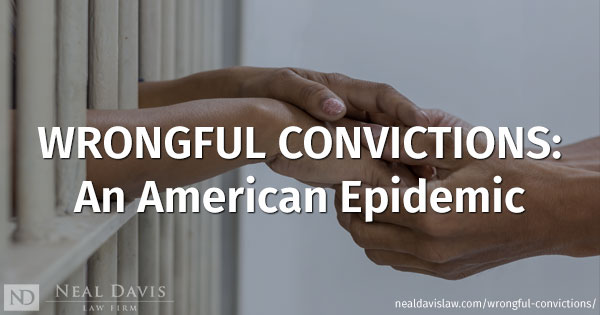
Exonerations By State (Report): Statistics on Wrongful Convictions in the United States
Exonerations rise nationally as falsely convicted Americans get justice

Just because all Americans are supposed to get their day in court doesn’t mean they get justice. But thanks to DNA testing, higher societal awareness and more prosecutorial accountability, the tide is turning from widespread incarceration to freedom and exoneration for wrongly imprisoned persons.
In the past 30 years, numerous injustices have led to more than 21,000 years lost in prison for persons who later were exonerated. A total of 2,468 people were exonerated between 1989 and 2019.
Wrongful convictions and exonerations are rising across the U.S. Find out what’s causing this disturbing trend and what can be done to stop it.
The National Registry of Exonerations found that Texas, despite having some of the toughest laws on crime, led the nation with 363 exonerations in the last 30 years. Other top states based on total numbers of exonerations were Illinois, New York, and California. In Louisiana, which had 63 exonerations in that period, New Orleans is said to be the wrongful conviction capital of the U.S.
| Wrongful convictions by state & type of offense Exonerations since 1989 | |||||||
|---|---|---|---|---|---|---|---|
| Type of crime | |||||||
| State | Murder | Sexual assault | Child sex abuse | Drugs | Robbery | Other | Total |
| Alabama | 13 | 4 | 5 | 2 | 1 | 3 | 28 |
| Alaska | 5 | 1 | 2 | 8 | |||
| Arizona | 12 | 1 | 1 | 1 | 1 | 7 | 23 |
| Arkansas | 4 | 1 | 2 | 2 | 1 | 10 | |
| California | 78 | 11 | 39 | 7 | 15 | 55 | 205 |
| Colorado | 5 | 3 | 1 | 2 | 11 | ||
| Connecticut | 15 | 4 | 2 | 4 | 25 | ||
| Delaware | 1 | 1 | 1 | 3 | |||
| Florida | 27 | 11 | 7 | 5 | 5 | 23 | 78 |
| Georgia | 18 | 8 | 1 | 1 | 3 | 6 | 37 |
| Hawaii | 1 | 2 | 3 | ||||
| Idaho | 2 | 1 | 2 | 5 | |||
| Illinois | 156 | 22 | 6 | 79 | 6 | 34 | 303 |
| Indiana | 14 | 8 | 5 | 2 | 7 | 36 | |
| Iowa | 4 | 3 | 2 | 1 | 5 | 15 | |
| Kansas | 3 | 3 | 1 | 1 | 3 | 11 | |
| Kentucky | 5 | 2 | 5 | 4 | 16 | ||
| Louisiana | 33 | 13 | 3 | 8 | 3 | 3 | 63 |
| Maine | 1 | 1 | 1 | 3 | |||
| Maryland | 1 | 1 | 1 | 3 | |||
| Massachusetts | 27 | 10 | 7 | 4 | 21 | 69 | |
| Michigan | 34 | 11 | 16 | 2 | 4 | 32 | 99 |
| Minnesota | 2 | 3 | 3 | 1 | 1 | 6 | 16 |
| Mississippi | 12 | 2 | 2 | 5 | 21 | ||
| Missouri | 27 | 9 | 6 | 3 | 3 | 2 | 50 |
| Montana | 4 | 4 | 4 | 1 | 2 | 15 | |
| Nebraska | 8 | 2 | 10 | ||||
| Nevada | 6 | 4 | 1 | 3 | 14 | ||
| New Hampshire | 1 | 1 | |||||
| New Jersey | 14 | 9 | 6 | 2 | 8 | 39 | |
| New Mexico | 5 | 1 | 1 | 1 | 8 | ||
| New York | 123 | 36 | 19 | 14 | 23 | 66 | 281 |
| North Carolina | 22 | 7 | 12 | 6 | 14 | 61 | |
| North Dakota | 2 | 2 | 4 | ||||
| Ohio | 31 | 10 | 14 | 4 | 8 | 16 | 83 |
| Oklahoma | 17 | 6 | 8 | 2 | 2 | 35 | |
| Oregon | 7 | 4 | 5 | 3 | 19 | ||
| Pennsylvania | 48 | 9 | 4 | 1 | 3 | 13 | 78 |
| Rhode Island | 3 | 1 | 1 | 1 | 6 | ||
| South Carolina | 4 | 2 | 1 | 7 | |||
| South Dakota | 1 | 3 | 2 | 6 | |||
| Tennessee | 11 | 3 | 3 | 10 | 27 | ||
| Texas | 49 | 40 | 38 | 173 | 17 | 46 | 363 |
| Utah | 6 | 3 | 2 | 1 | 4 | 16 | |
| Vermont | 1 | 1 | 2 | ||||
| Virginia | 18 | 22 | 2 | 2 | 3 | 9 | 56 |
| Washington | 6 | 8 | 18 | 2 | 7 | 11 | 52 |
| West Virginia | 4 | 6 | 10 | ||||
| Wisconsin | 12 | 15 | 10 | 5 | 18 | 60 | |
| Wyoming | 2 | 1 | 1 | 4 | |||
| 901 (38%) | 316 (13%) | 271 (11%) | 322 (13%) | 126 (5%) | 462 (19%) | 2,398 | |
Visit the National Registry of Exonerations website to see a map of the total number of exonerations for each state since 1989.
10 best & worst states for exonerations
What’s interesting is that while some of the most populated states (like California, Texas, New York) predictably have some of the highest rates of exoneration, this correlation between state population size and the number of exonerations isn’t direct.
For instance, Illinois, which ranks 6th in population, comes in 2nd in number of exonerations. Likewise, even though California is the most populous state, it ranks 4th in number of exonerations — falling behind Texas, Illinois and New York.
| 5 States with MOST exonerations Since 1989 | ||||
|---|---|---|---|---|
 Texas Exonerations: 363
Years lost: 2,066 Mostly men (84%) Mostly Black Americans (47%) Mostly drug crimes (48%) |  Illinois Exonerations: 303
Years lost: 2,801 Mostly men (95%) Mostly Black Americans (74%) Mostly murder crimes (51%) |  New York Exonerations: 281
Years lost: 2,716 Mostly men (94%) Mostly Black Americans (53%) Mostly murder crimes (44%) |  California Exonerations: 205
Years lost: 1,712 Mostly men (90%) Mostly White Americans (47%) Mostly murder crimes (38%) |  Michigan Exonerations: 99
Years lost: 896.5 Mostly men (91%) Mostly Black Americans (52%) Mostly murder crimes (34%) |
On the flip side, some states with larger populations haven’t made it a priority to pursue wrongful convictions, leading to lower than expected numbers of exonerations. For example, while Florida ranks 3rd in population, it comes in at number 9 in number of exonerations.
Again, the states with the smallest populations don’t necessarily have the least number of exonerations, as you might expect. For instance, Wyoming is the least populous of any state and yet ranked 41st in number of exonerations. Generally speaking, though, the states with the fewest exonerations were also towards the bottom in terms of population.
| 5 States with FEWEST exonerations Since 1989 | ||||
|---|---|---|---|---|
 New Hampshire Exonerations: 1 |  Vermont Exonerations: 2 |  Delaware Exonerations: 3 |  Hawaii Exonerations: 3 |  Maine Exonerations: 3 |
It’s worth noting that Maryland also had 3 exonerations since 1989, tying with Delaware, Hawaii and Maine.
Texas still leads nation in exonerations
The Texas Tribune reported that Texas currently leads the nation in exonerations, despite fewer drug defendants being exonerated recently. Beyond that, Harris County led the nation in exonerations in 2017.
In fact, Texas is among 33 states which provide some restitution for the exonerated. It offers individuals who were exonerated and released $80,000 per wrongly imprisoned year, plus an annuity and some reintegration and financial assistance as well as legal fees and missed child support payments.
With an average of 5.69 years lost per exonerated person in Texas, the state’s payment averages almost half a million dollars for each person exonerated. In 2018, Texas exonerated 16 cases, which means the state paid out approximately $7 million in that year alone.
Individuals in states without exoneration laws are left to file a federal civil rights case for wrongful conviction and imprisonment in order to gain financial compensation. But even in states like Texas which have exoneration laws and which offer remuneration, such a lawsuit may be needed to gain fair restitution.
Louisiana, for example, offers a maximum of only $250,000, paid out over 10 years, to those who were falsely imprisoned and later exonerated. By contrast, New York has no limit on how much exonerees can be awarded.

The reasons behind exonerations
The impetus behind exoneration can include many factors, such as DNA testing, as championed by The Innocence Project. DNA reportedly has been involved in around one-fourth of all exonerations since 1989, the year in which it began being used as evidence. Such evidence allows investigators to go back to years-old events to determine proof of innocence.
TIME Magazine reports that another reason for more exonerations is “a growing trend of accountability in prosecutorial offices around the country.” TIME cited Harris County as being a leader in exonerations. It said the county’s conviction review unit has totaled 128 exonerations, or 15 percent of all exonerations in the United States, since its first full year in operation in 2010.
TIME also said that Harris County identified a problem which may be systemic across the country, and the county has spent the last two years actively trying to right its wrongs. That problem involved cases in which drugs had been initially identified as illegal substances but were in fact misidentified by defective field test kits.
Harris County District Attorney Kim Ogg was quoted as saying, “We take every case of wrongful conviction seriously. It’s a threat to the public trust.” Ogg intends to keep the conviction review unit open to make the judicial system more trustworthy.
According to the National Registry of Exonerations, over 50 percent of exonerations involve false accusations or perjury, most often in cases of homicide and child sex abuse. In sexual assault cases, mistaken witness identification frequently is an issue.
In short, these are the primary contributing factors why exonerations are necessary:
- False confessions
- False accusations
- Perjury
- Mistaken identity
- Official misconduct
- Bad forensic evidence
Exonerations & racial bias
An important issue in the fight for exonerations is an underlying question:
Why are unjust arrests and convictions happening in the first place?
Studies have shown that racial bias is a major factor. One such study is by Samuel Gross, a University of Michigan law professor and senior editor and co-founder of the National Registry of Exonerations.
Gross found that though sexual assaults by black men on white women are a small minority of all sexual assaults, they comprise half of sexual assaults with eyewitness misidentification.
Further, though blacks are 13 percent of the U.S. population, they comprise 38 percent of those imprisoned. Blacks are also more likely to be targets of police misconduct and get harsher sentences than whites for the same crimes. As a result, those who eventually are exonerated for sexual assault or murder have spent years longer in prison before being set free.
Racial profiling by police who target minorities has come under fierce fire in recent years.
In one of the most notorious cases of profiling, five black and Hispanic men — who later became known as the Central Park Five — were convicted of assaulting and murdering a jogger in New York’s Central Park. The men served 7 to 13 years in prison, but after much publicity and legal wrangling they were exonerated in 2002. They received a $40 million settlement from New York City in 2014. The Central Park Five were featured in the Netflix miniseries “When They See Us” (released on May 31, 2019), and received a standing ovation at the ensuing BET Awards.
That’s not to say all exoneration cases merit such celebration. Media personality and publicity hound Kim Kardashian, who has proclaimed that she will pursue a legal career, has supported longtime California death row inmate Kevin Cooper, a man whom many believe deserved his conviction for murdering four people in the 1980s.
#MeToo movement spurs false sex crime claims
Another major factor in recent unjust arrests involves the so-called #MeToo movement, which has snowballed in recent years as more and more women have spoken out to accuse men of sexual assault and sexual abuse. While numerous such claims may be true, the trend has led to many men being falsely accused of sex crimes — along with many young students in today’s high schools, as Davis points out:
“I’m representing three kids from the same private school in Houston who all have been accused of sex crimes despite much evidence — including witnesses and texts from the alleged victims — showing that the sex they had was consensual,” said Neal Davis. “The current climate is almost a hysteria, like the Red Scare of the 1950s. Many parents fear what can happen to their sons.”
Death row exonerations most needed
Those most needing exoneration are those who face the ultimate penalty, having been unjustly placed on death row in U.S. prisons. Once they’ve been executed, exoneration can do no more than clear their name.
Gross published a paper in 2014 which estimated that 4.1 percent of people on death row are innocent, but only 1.8 percent have been exonerated.
One man who wasn’t exonerated in time was Cameron Todd Willingham of Texas. He was executed for killing his three children by arson at their home in Central Texas. But now, he is widely considered to have been innocent, as highlighted in the film “Trial by Fire,” released in 2019. For Willingham, exoneration didn’t come soon enough.
Data sources: The National Registry of Exonerations, a project of the University of California Irvine Newkirk Center for Science & Society, the University of Michigan Law School & Michigan State University College of Law. Data was last updated as of June 24, 2019.
State populations based on data from the US Census Bureau’s “Annual Estimates of the Resident Population for the United States, Regions, States, and Puerto Rico: April 1, 2010 to July 1, 2018.” Data estimated as of July 1, 2018.
NealDavisLaw.com assumes no responsibility for inaccuracies or for changes in such information that may occur after publication. Please see the National Registry and US Census websites for up-to-date figures.
Texas court process for criminal charges
Understand how Texas criminal cases proceed and what to expect throughout the judicial process.


